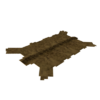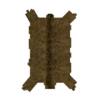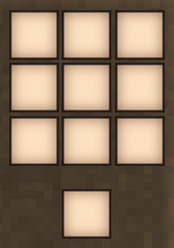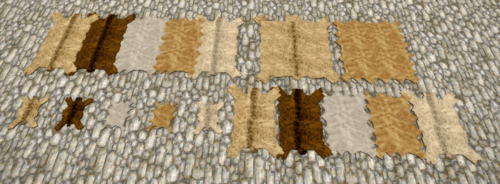Pelt: Difference between revisions
(created page outline) Tag: Removed redirect |
(reorganized and rephrased) |
||
| (3 intermediate revisions by 2 users not shown) | |||
| Line 1: | Line 1: | ||
<languages/> | |||
{{GameVersion|1. | {{GameVersion|1.19.7}} | ||
<translate> | <translate> | ||
'''Pelts''' are | '''Pelts''' are animal {{ll|Hide|skins}} that have been treated with oil. | ||
</translate> | </translate> | ||
<div style="float:right;"> | <div style="float:right;"> | ||
{{Block | {{Block | ||
|Name=Pelt (Large) | |||
|Image=File:placed-hide-pelt-large.png | |||
|Material= | |||
|Stackable=1 | |||
|Drops=Itself | |||
}} | |||
{{Item | |||
|Name=Pelt (Large) | |Name=Pelt (Large) | ||
|Image=File:hide-pelt-large.png | |Image=File:hide-pelt-large.png | ||
|Material= | |Material= | ||
|Stackable= | |Stackable=32 | ||
}} | }} | ||
</div> | </div> | ||
| Line 21: | Line 26: | ||
== Creation == | == Creation == | ||
Making pelts is much simpler than making leather. | Making pelts is much simpler than making leather. | ||
Start by collecting raw hides from animal corpses, and lumps of fat from medium and large animals. | Start by collecting raw {{ll|Hide|hides}} from animal corpses, and lumps of {{ll|fat|fat}} from the corpses of medium and large animals. | ||
=== | === Oiling === | ||
Next, use fat to oil the raw hides. Place the fat and hide(s) in the crafting grid.<br> | |||
1 lump of fat can oil 1-4 small hides, or 1-2 medium hides, or 1 large hide. To oil a huge hide, stack 2 fat in the crafting grid. | |||
</translate> | </translate> | ||
| Line 38: | Line 45: | ||
<translate> | <translate> | ||
=== Curing === | |||
Next, these oiled hides need to "cure"; simply leave them somewhere for 48 hours. There is nothing you can do to hasten the process, and the storage place doesn't matter. The tooltip on the hide will display how much the curing has progressed; upon reaching 100%, they become {{ll|Pelt|pelts}} that can be used in different crafting recipes than raw hides can. | |||
== Usage == | == Usage == | ||
* | * Crafting a full set of any lamellar armor requires 9-10 small pelts, 5 medium, 4 large, or 3 huge pelts. | ||
* | * Crafting a [[Clothes#Upper_Body_Over|fur coat]] requires 1 huge pelt, or a greater quantity of smaller pelts. | ||
* | * Crafting [[Clothes#Foot|knee-high fur boots]] requires 1 large pelt, or a greater quantity of smaller pelts. | ||
* | * Crafting [[Clothes#Hand|fur gloves]] requires 1 large pelt, or a greater quantity of smaller pelts. | ||
* | * Crafting [[Clothes#Foot|fur lined reindeer herder shoes]] requires 2 small pelts, or 1 of any larger pelt. | ||
* | * Crafting a [[Clothes#Upper_Body_Over|reindeer herder fur coat]] requires 4 small pelts, or 2 of any larger pelt. | ||
* | * Crafting a [[Container#Portable_containers|hunter backpack]] requires 3 small pelts, or 1 of any larger pelt. | ||
* Crafting a [[longbow]] requires 1 leather or 1 pelt (small or medium). | |||
== Storage == | |||
* Whether curing or cured, pelts can be placed on the ground with {{keypress|Shift}}+{{RMB}}; the curing process continues on the ground. | |||
* They stack up to 32 inside reed chests, wooden chests and trunks, clay storage vessels, and barrels.<br> | |||
* Temperature has no effect on the curing process. Oiled hides progress at the same rate whether stored in a cellar or exposed to sunlight. | |||
Combining stacks averages the curing progress: adding a freshly-oiled hide to one 50% cured will result in two at 25% progress. | |||
== History == | == History == | ||
* Icons and models were changed in 1.19.4-rc.1 | * Icons and models were changed in 1.19.4-rc.1 | ||
"Hides have new models and textures, and can be placed on the ground" | "Hides have new models and textures, and can be placed on the ground" | ||
== Notes == | == Notes == | ||
* Pelts are commonly defined as "a usually unfinished skin with its hair, wool, or fur."<ref>m-w.com</ref> | |||
== Gallery == | == Gallery == | ||
[[File:hides-1194-rc.1.png|500px]] | [[File:hides-1194-rc.1.png|500px]] | ||
== See also == | == See also == | ||
* [[ | |||
* [[Leather working]] | |||
== References == | == References == | ||
<references /> | <references /> | ||
</translate> | </translate> | ||
{{Game navbox}} | {{Game navbox}} | ||
Latest revision as of 22:41, 7 April 2024
This page was last verified for Vintage Story version 1.19.7.
Pelts are animal skins that have been treated with oil.
Creation
Making pelts is much simpler than making leather. Start by collecting raw hides from animal corpses, and lumps of fat from the corpses of medium and large animals.
Oiling
Next, use fat to oil the raw hides. Place the fat and hide(s) in the crafting grid.
1 lump of fat can oil 1-4 small hides, or 1-2 medium hides, or 1 large hide. To oil a huge hide, stack 2 fat in the crafting grid.
| Ingredients | Crafting Recipe |
|---|---|
| 1x Fat 1x Raw hide |
Curing
Next, these oiled hides need to "cure"; simply leave them somewhere for 48 hours. There is nothing you can do to hasten the process, and the storage place doesn't matter. The tooltip on the hide will display how much the curing has progressed; upon reaching 100%, they become pelts that can be used in different crafting recipes than raw hides can.
Usage
- Crafting a full set of any lamellar armor requires 9-10 small pelts, 5 medium, 4 large, or 3 huge pelts.
- Crafting a fur coat requires 1 huge pelt, or a greater quantity of smaller pelts.
- Crafting knee-high fur boots requires 1 large pelt, or a greater quantity of smaller pelts.
- Crafting fur gloves requires 1 large pelt, or a greater quantity of smaller pelts.
- Crafting fur lined reindeer herder shoes requires 2 small pelts, or 1 of any larger pelt.
- Crafting a reindeer herder fur coat requires 4 small pelts, or 2 of any larger pelt.
- Crafting a hunter backpack requires 3 small pelts, or 1 of any larger pelt.
- Crafting a longbow requires 1 leather or 1 pelt (small or medium).
Storage
- Whether curing or cured, pelts can be placed on the ground with Shift+
 ; the curing process continues on the ground.
; the curing process continues on the ground. - They stack up to 32 inside reed chests, wooden chests and trunks, clay storage vessels, and barrels.
- Temperature has no effect on the curing process. Oiled hides progress at the same rate whether stored in a cellar or exposed to sunlight.
Combining stacks averages the curing progress: adding a freshly-oiled hide to one 50% cured will result in two at 25% progress.
History
- Icons and models were changed in 1.19.4-rc.1
"Hides have new models and textures, and can be placed on the ground"
Notes
- Pelts are commonly defined as "a usually unfinished skin with its hair, wool, or fur."[1]
Gallery
See also
References
- ↑ m-w.com
| Wiki Navigation | |
|---|---|
| Vintage Story | Guides • Frequently Asked Questions • Soundtrack • Versions • Controls |
| Game systems | Crafting • Knapping • Clay forming • Smithing • Cooking • Temperature • Hunger • Mining • Temporal stability • Mechanical power • Trading • Farming • Animal husbandry |
| World | World generation • Biomes • Weather • Temporal storms |
| Items | Tools • Weapons • Armor • Clothing • Bags • Materials • Food |
| Blocks | Terrain • Plants • Decorative • Lighting • Functional • Ore |
| Entities | Hostile entities • Animals • NPCs • Players |
| Miscellaneous | List of client commands • List of server commands • Creative Starter Guide • Bot System • WorldEdit • Cinematic Camera • Adjustable FPS Video Recording • ServerBlockTicking |



